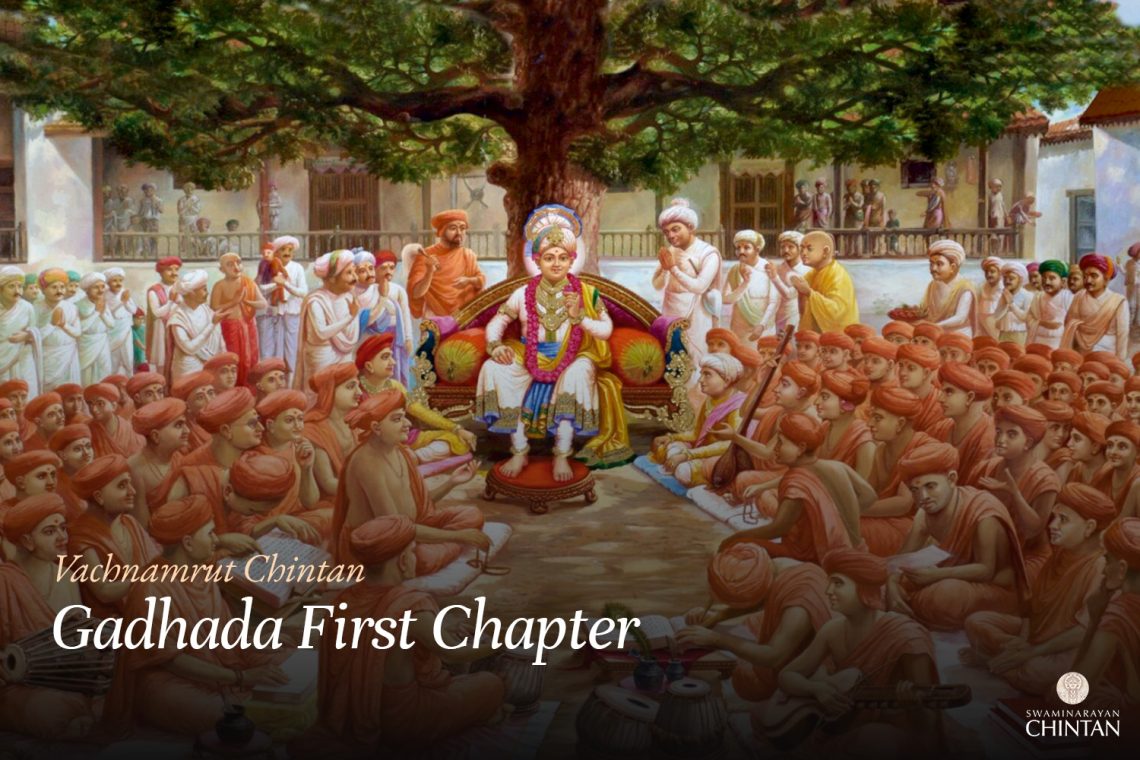Central Insights:
- The reasons for the manifestation of virtues such as Satya (truth) and Shaucha (cleanliness) in devotees of God.
Key Points:
Even with a conviction in God, if a devotee lacks the right attitude and mistreats true devotees, virtues will not manifest. Instead, demonic qualities will arise.
Explanation
In this Vachanamrut, Swami Svayamprakashanand poses a question about how the virtues of Satya and Shaucha, which are eternally present in the form of God, manifest in a saint. Maharaj responds that these virtues manifest in a saint when there is a true conviction of God’s form. This conviction must be unwavering and not equate God to any other entity. When such a firm conviction is established, it is said that the devotee has formed a relationship with God, and as a result, God’s virtues manifest in them.
Nirvikaranand Swami then expresses a doubt, noting that often in the Satsang, despite having conviction, virtues do not manifest and negative qualities like ego and jealousy increase. Maharaj resolves this by explaining that if a soul has demonic tendencies and unworthiness, then even with conviction in God, divine virtues do not manifest. Instead, demonic qualities like ego and jealousy intensify. Therefore, along with the conviction in God, there must be a sense of sevakbhāv (servitude) and nirmāṇībhāv (humility) towards the devotees of God. If a devotee harbors ego, jealousy, or malice towards other devotees, demonic qualities will increase, and divine virtues will not manifest.
Thus, in the manifestation of divine qualities such as Satya (truth) and Shaucha (cleanliness) in devotees, the conviction in God serves as the inherent cause (samavayi karan). The attitude of service and humility towards devotees of God acts as the immediate cause (asamavayi karan). The grace of the devotees serves as the instrumental cause (nimitta karan).
Samavayi karan refers to the material cause. For instance, threads are the material cause of cloth. Similarly, the conviction in God functions as the material cause for the manifestation of divine qualities. In contrast, asamavayi karan refers to a cause that, when destroyed, leads to the immediate cessation of the effect, and its association is necessary for the effect to be produced.
The attitude of service and humility towards the devotees of God acts as the immediate cause for the manifestation of divine qualities. This means that even if there is conviction in God as the material cause, without the attitude of service and humility towards the devotees, the manifestation of divine qualities does not occur (the effect is not produced). When the immediate cause is removed, the effect immediately ceases. Thus, when humility and the attitude of service towards the devotees of God are removed, the divine qualities immediately dissipate. For example, in the case of Purnanand Swami, Ramandalik, Meghji Sukhadiya, and Raghunathdas, the resolve of the pleased devotees of God acts as the instrumental cause for the manifestation of divine qualities. In the context of cloth, the weaver is the instrumental cause. The loom and other assisting causes are secondary causes. Similarly, for the manifestation of divine qualities, auspicious time, place, and company are secondary causes.
The difference between asamavayi karan (immediate cause) and samavayi karan (inherent cause) is that the inherent cause is not subject to destruction, whereas the immediate cause is. Consequently, the divine qualities of God do not dissipate due to the destruction of the inherent cause; however, if there is no attitude of service towards the devotees of God, then these qualities do not manifest in the devotee.
The difference between the immediate cause (asamavayi karan) and the instrumental cause (nimitta karan) is that the effect remains visible or active only as long as the immediate cause is present, whereas the instrumental cause does not require continuous presence. Even after the divine qualities have manifested, the constant presence of an attitude of service towards the devotees of God is necessary to maintain them; otherwise, the effect will dissipate.
The difference between the instrumental cause (nimitta karan) and the secondary cause (sahakari karan) is that the instrumental cause has the power to terminate the effect, while the secondary cause does not possess such power.
From this discussion, it becomes clear how essential and vital a true devotee of God is on the path to liberation. To illustrate, Maharaj provides the example of Hiranyakashipu, showing that even though divine qualities may manifest, such as in the case of Jay and Vijay, who were gatekeepers in the divine abode and attained samipya, sarupya, and sayujya mukti (types of liberation), they fell due to their arrogance and disrespect towards the sages Sanak and others. Similarly, Hiranyakashipu possessed divine, all-knowing power and strength, but his mistreatment of Prahlad led to a tragic end. Hence, Shriji Maharaj emphasizes that devotees of God should never insult any devotee or the poor, nor should they cause harm or sorrow to them. They should remain humble and serve others.
Glossary
| Asamavayi Karan – Immediate cause. A cause necessary for the manifestation and continuation of an effect, such as service and humility towards devotees. |
| Conviction – Firm belief in God’s divine form and greatness. |
| Demonic Tendencies – Negative qualities such as ego, jealousy, and malice. |
| Instrumental Cause – A contributing factor such as the blessings of saints that enables the emergence of divine virtues. |
| Nimitta Karan – Instrumental cause. A cause that facilitates the manifestation of divine qualities, such as the blessings of devotees of God. |
| Nirmanibhav – Humility. |
| Nishchay – Firm Faith in Manifested God Believing Manifested God (Bhagwan Swaminarayan) as “My Beloved God” (My Istadev) |
| Sahakari Karan – Secondary cause. Supporting factors like time, place, and association, which aid in the manifestation of divine qualities. |
| Samavayi Karan – Inherent cause. The material cause, such as conviction in God, which is essential for the manifestation of divine qualities. |
| Sanak – Refers to one of the four eternal sages, known for their detachment and spiritual wisdom. |
| Sevakbhav – Attitude of servitude. |
| Shaucha – Cleanliness or purity. |

